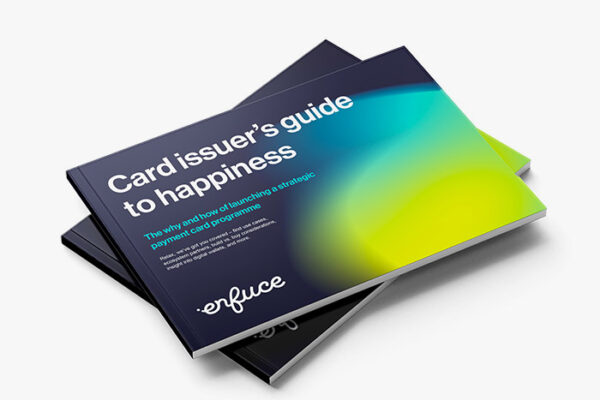Insights from Qred: How to simplify payments for small businesses with a credit card

Qred is focused on helping SMEs pay effortlessly in their day-to-day operations. When they set out to complement their lending offering with payment services for small businesses, they interviewed many operators in the industry and found that Enfuce was a good match to support their vision going forward.
Watch the full recording here: Webinar recording with Qred: How small businesses pay in the future
In this article, you’ll learn about Qred’s path to launching their card product, Qred VISA, how Enfuce supported them in the process, and where they see their product evolving in the future. You’ll learn about the typical bumps in the road and how to overcome them in your own card launch project.
You’ll also have a chance to take a glimpse at the highlights of our joint webinar, where Thomas Jansson, Co-Founder and Chief Growth Officer at Qred shares his insights, accompanied by Enfuce’s Customer Success Manager, Michael Fabricius, and Product Manager, Linda Buss.
By reading this article – or alternatively, checking out our webinar snippets – you’ll learn about:
- Filling the gap in payment services, and how consumer behaviour is driving better payment services for SMEs
- Quick and straightforward onboarding: how to take a multi-party project successfully over the finish line
- How to navigate the complexities of payment tech with the right partner
- How the near future brings expansion to new markets and better service through new features
1. Payment services for small companies – how to fill the gaps?
Small businesses’ needs and challenges vary based on the industry. However, there are some common denominators: everybody wants simplicity, accessibility, and ease of use.
Thomas Jansson
As Qred began their journey in the lending market for small businesses, they soon realised that the payment services provided for small and micro-organisations were rather insufficient. As their greatest focus is easing the day-to-day of this segment, they decided to fill this gap in payment services.
Credit cards vs. open banking
It wasn’t clear from the beginning that Qred would solve this problem for small businesses by launching credit cards. Instead, they were exploring many options. One of those was open banking, which was a trending topic at the time.
But since the goal was to provide payments in a simple, easy, and accessible way, Qred was concerned about whether an open banking solution would be an easy and intuitive option for small businesses.
“That’s where payment cards came in. Since entrepreneurs already use payment cards in their everyday lives as consumers, there’s virtually no knowledge gap,” Jansson explains.
Cards also enabled a more streamlined onboarding for the end users: effectively a self-service, with support available whenever needed.
Consumer expectations shape the payment services for small businesses
“Payment solutions provided by banks have traditionally been tailored to the needs of large corporations. Those solutions have then been slightly modified for small businesses, often resulting in lower service quality,” Thomas Jansson notes.
Small businesses need better and faster payment services than they have had available. The segment is growing fast and employing more and more people every day. The entrepreneurs’ challenges cannot be ignored any longer.
A change for the better is already on its way – and it’s coming from the consumer space. The modern payment landscape for small businesses is in fact strongly shaped by consumer behaviour.
“An essential part of the change is viewing SMEs as people and not as faceless companies,” Linda Buss asserts.
Small business entrepreneurs are typically business owners by day and consumers by night – and sadly, they tend to get served differently by banks, depending on the role they take. As a consumer, the service is smooth, fast and of high quality. For entrepreneurs, it can be quite the opposite. Decisions tend to take a long time and services come with additional fees.
Now, the business owners are demanding the same service level that they’re familiar with as consumers – and fintechs are more than capable of providing it. The starting point is of course paying attention to the SME customers’ wants and needs. Modern technology then helps keep the offering relevant. With agile approaches, you can easily adapt to changes arising from the consumer space.
2. How to onboard – from an idea to a successfully launched credit card
Qred had some key requirements for the project of setting up the new credit card product. The main goal was to get the product to the market within the mutually agreed timeline. Time is the most critical resource for a startup so speed was of the essence, along with clear communications and a shared startup mentality.
Taking a multi-party implementation project over the finish line is indeed not a walk in the park.
“We were not experts in the payments space when starting the project. We received a lot of insight from Enfuce to help shape the expectations, requirements, and timeline,” says Thomas Jansson.
Three things that make a smooth onboarding: tech, people and processes
Smooth project onboarding is not just a tech project but also a collaboration project. Here are the three cornerstones of how Enfuce plans the onboarding:
- Tech. Having clear documentation and a structured plan is key. Proven and tested off-the-shelf features make sure that you don’t have to start from scratch every time. The tech also needs to be secure, compliant and scalable.
- People. More accurately, ensuring contact with the right people for each project. Enfuce always assigns a specific Customer Success Manager that’ll be your one-stop contact for anything you need. The CSM also makes sure the project proceeds in the intended timeline and gets you access to the resources you need, when you need them.
- Processes. Enfuce’s onboarding follows a four-phase project structure that helps you build your app towards Enfuce APIs in a focused way. You won’t have to wait for large building blocks to fall in place before you can start.
Onboarding challenges – and how to overcome them
“Let’s be honest,” says Thomas Jansson. “No project ever is perfect. But stumbling upon surprising situations and quickly finding solutions is at the core of the fintech world.”
Flexibility is a must. You need to adjust your plans as you go.
Coordinating a multi-party project involving not just Enfuce and Qred but also the card manufacturer and the card scheme is of course difficult. Clear and open communication can help synchronise timelines and make a complex project with multiple players more straightforward.
“You also need continuous adjustments to ensure you’re not completely blocked due to waiting for one player. If some part is not moving along due to reasons you cannot affect, it’s important to continue reprioritising other things to keep the project running,” Michael Fabricius adds.
What then helps you overcome these challenges?
- Make sure you have a clear picture of what you’re about to do
- Learn what kind of dependencies there are
- Use your network to spar for ideas and understand what is possible
- Figure out what value you want to bring, and how challenging it is to achieve
- Be willing to adjust the project plan whenever needed
3. Payment tech is complex – so find the right partner
What should you consider when planning a new offering? Well, there’s the choice between principal card scheme membership and BIN sponsorship, what to outsource and what to do in-house, how to build the technical solution and whatnot.
As if the payments business world isn’t complicated enough, there are no one-size-fits-all solutions. All choices depend on your company’s size, vision and needs.
Nobody has all the answers but a good partner with expertise in the payments world is invaluable. Let’s look at how Qred navigated the complexities of payment tech.
Visa principal memberships vs. BIN sponsorship?
For Qred, one of the first decisions in the payments world was choosing between a Visa principal membership and a BIN sponsorship.
“Since we already had a strong vision for where we wished to take our product in the future, we looked for an option that would enable our goals,” says Thomas Jansson.
A BIN sponsorship is a common choice for smaller companies, as it enables access to more guidance during the process. However, Qred concluded that a BIN sponsorship would have also added one extra player to the game, and along with that, another dependency.
This of course clashed with the goal of providing simple, easy and fast solutions for their end customers. Hence, they found that applying for a Visa principal membership themselves was the most suitable option.
Setting up the technical solution – and overcoming typical challenges
The starting point for any project is pretty much the same on Enfuce’s side. The turnkey solution consists of ready-made building blocks and off-the-shelf features. Those can be put together in different ways to help you achieve your unique goals.
The second important aim is fast deployment in test environments. This helps us ensure a fast pilot launch as well. And the work doesn’t end at launch. Once you’re in the market, there’s still plenty of room for building customised features that differentiate you from the competition.
“No matter how well you plan the project, you can’t avoid all the bumps in the road. Requirements can be overlooked and unforeseen circumstances might arise. Acknowledging the possibility of these typical hiccups is a sign of realism in project planning. Then, overcoming them is all about cooperation, coordination and communication,” Linda Buss explains.
Ensuring a user-friendly solution – without compromises on compliance
Meeting compliance requirements is a must. Ensuring a user-friendly technical flow is also needed to compete in today’s market. Of course, you’d want to excel in both, but it takes a lot of work and expertise to fit these two goals together. And more often than not, it’s difficult to be an expert in both.
Luckily, no one must tackle this challenge alone: if there’s something you struggle with, you can outsource it to a competent payment processing partner. Being able to distribute responsibilities is in fact one of the greatest advantages in multi-party projects.
Since regulatory aspects are Enfuce’s core competence, Qred got the support they needed in this area. And with Enfuce handling the nitty-gritty, Qred freed up time to focus on the user experience.
Linda Buss
Your partner can easily help you sail through the sea of compliance and regulatory matters. They can also speed up the processes to get the issuers and BIN sponsors up to the game.
4. What future plans does Qred have?
“We are always working to improve our solution and make our customers happier by providing them easier and more frictionless access to payments and financing,” says Thomas Jansson.
In the future, Qred’s aim is to grow by introducing new value-adding features and expanding to new markets.
Introducing new features
Qred recently expanded their offering in Sweden by introducing a finance payment solution that allows small businesses to pay off purchase invoices in a few clicks using the Qred VISA. Invoices are still a central part of small business payments and strongly built into the small business owners’ behaviours. The useful addition further streamlines the day-to-day payments for small businesses.
Another new release is a cashback reward programme. The day-to-day of a small business is full of micro-payments for materials, online purchases, marketing, groceries, and the like. Now, the users can earn money by using the card for their business purchases. This is a unique benefit that no other card programme offers to the segment at the moment.
All development decisions should be driven by the end customers’ needs and wants. Listen to those attentively, and be willing to change your product roadmap accordingly. So, don’t stick to a fixed plan but aim for agility and adaptability.
“And whenever it’s possible, test the new features before scaling them,” Jansson reminds.
Expanding to new markets
Scalability across markets is in Qred’s DNA. Qred started out as a financial provider, granting direct loans to small businesses, and have since then entered a new market almost every year.
It doesn’t hurt that payment services are fairly standardised: Mastercard’s and Visa’s offerings work the same way across Europe, and beyond.
Thomas Jansson
The entire card launch project with Enfuce was planned with international scalability in mind.
“Despite there being a turnkey solution with tested building blocks, some tailoring is needed for each market. First, you run a quick pilot to ensure a smooth entry. Then, you can create versatile features for multiple purposes. It’s all about moulding, switching and configuring,” Linda Buss explains.
Key takeaways: How to succeed with payments for Small Businesses
Success in the payments industry can come in many forms, but we’d still like to conclude with some tips. This is how you overcome any obstacles in challenging projects:
- Never underestimate how valuable customer insights can be. Make use of them – or rather, don’t make decisions without them.
- Test to impress. It’s only natural that you don’t have all the answers right away, but test what you can to learn and improve. Don’t be afraid to open new doors while maintaining the fintech mindset.
- Be prepared for any bumps in the road. Only so much can be planned in advance. Take that as a given rather than as something unexpected. And be willing to adjust your roadmap whenever needed.
Did you enjoy what you just read? Learn more about how Enfuce helped Qred complement their service offering for small businesses with a credit card.
Are you also looking to fuel growth for your fintech by launching payment cards? Here’s what you should expect when you start working with Enfuce:
- We start by asking you what you’d like to achieve through our collaboration.
- Through our experience in working with fintechs across Europe, you’ll have the best expertise in payments processing helping you achieve these goals.
- We’ll help you build and rework your roadmap and create a realistic plan.
- You’ll get open, clear and prompt communication even when it’s about complex technical details
- And we’ll deliver what we promised to deliver.
Does this tick all the boxes for you? Then don’t hesitate to contact us!



